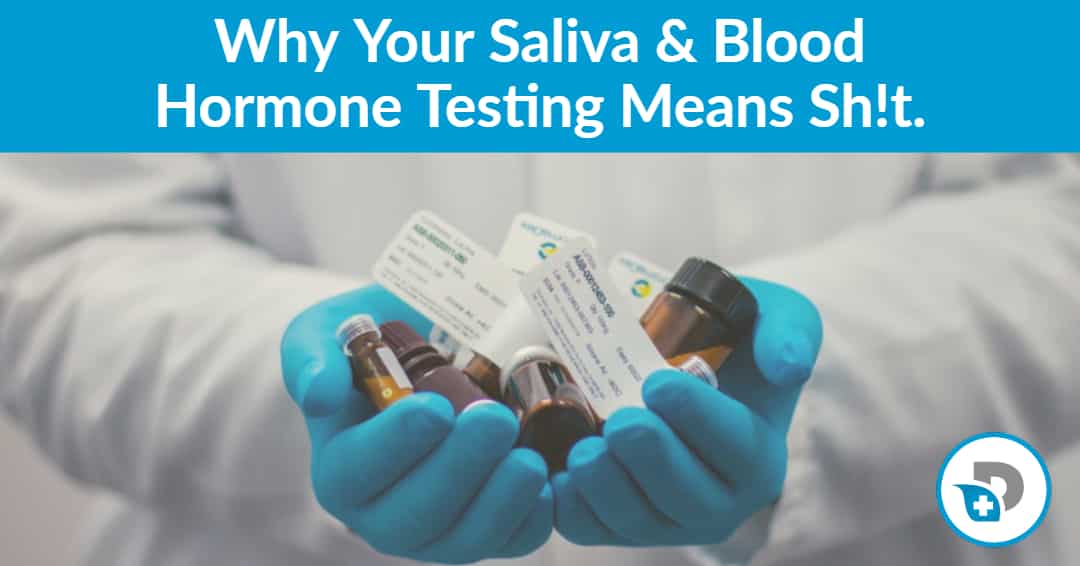
Why Your Saliva & Hormone Testing Means Sh!t
- by Dr. Daniel
- Published on

Doctors have three options for hormone testing – serum, saliva or urine.
Each of these testing methods is a viable option, but by themselves they are nearly useless for clinical recommendations.
As a long time chiropractic physician, I have spent the vast majority of my life studying human physiology and performance.
Certified in functional medicine, I’m always looking for reliable tests to confirm or deny my clinical suspicions and help patients achieve a higher level of function and performance.
Nothing irritates me more than someone who comes to me with a set of test results that quite literally mean shit in the realm of function and performance.
So here’s my attempt to clear things up with respect to salivary (spit), serum (blood) and urine (pee) hormone testing.
In my world, body fluids remain the most valuable source of information along with a thorough history.
As I always say, let’s test, not guess.
As a health provider, the most common fluids I’m interested in are blood, urine, saliva and sh!t (stool).
Each one has its particular strengths and weaknesses, but they do not provide enough information by themselves.
Therein lies the problem.
Performing and analyzing just 1 of these panels is not comprehensive enough to really know what's going on, much less make a solid recommendation.
Advantages and Disadvantages of Blood Hormone Testing
Advantages: Ideal for measuring hormone concentrations in the blood or plasma. Accurate for circulating hormones (not bioavailable hormones)
Disadvantages: Does not measure bioavailable hormone or how those hormones are being metabolized in your body. It's also just a “snapshot” of what's happening.
Drawing blood or pricking your finger for hormones has long been accepted by the conventional medical community as the standard for measuring hormones.
There’s something “legit” about drawing blood and it’s also a pretty simple process that doesn’t take much time to do at all.
This makes serum or blood testing ideal for testing peptide hormones such as FSH, LH, prolactin, fasting insulin, and thyroid hormones including Reverse T3, as well as thyroid antibodies.
It is also used to measure Sex Hormone Binding Globulin (SHBG) and, less commonly, Cortisol Binding Globulin (CBG).
For sex hormones, blood testing is accurate but limited.
Why?
For most sex hormones, no distinction is made in serum between bound and free hormone.
This means you have no way of knowing the difference between a hormone that’s circulating in your blood versus actual uptake or utilization of that hormone in your tissue.
Estradiol, estrone, estriol and progesterone are reported as total hormone and free hormones assays are not commonly available.
This may lead to misleading results in which hormone levels appear to be normal or even high normal because of an abundance of bound hormone.
However, if your free hormone level is low, you can be functionally deficient even with a normal total hormone level.
Serum testosterone is an exception in that it is commonly available as both total and free, and therefore can be useful in assessing hormone balance.
But not so fast…
Another limitation of serum hormones testing is the “snapshot” nature of single point testing.
Because hormones are secreted in a pulsatile manner over the course of the day (and night), it is difficult to know whether the levels in serum represent a peak, a valley, or something in between. [1, 2]
This means that you could have a blood draw at 9 AM, 11 AM, 2 PM and 4 PM and 6 PM and you'll find that your estrogen levels go from high to low in the same day.
This also presents a difficulty in monitoring treatment, as it is not possible to know whether today’s test was drawn at a similar point of hormone secretion as a previous test.
Finally, serum hormone testing does not typically allow for the measurement of estrogen, androgen, and adrenal metabolites, which can provide a wealth of information to assist in understanding of your condition and help to guide and fine-tune treatment options.
Advantages and Disadvantages of Saliva Hormone Testing
Advantages: First, it's non-invasive and can be done easily in your home. This also allows for multiple data points throughout the day. It's a great way to measure Free Hormone or Bioavailable hormone.
Disadvantages: Accuracy starts to head south because of many factors including saliva production.
Over the last 10 years it appears that everyone is now doing salivary testing.
Saliva has the advantage of being non-invasive as well as being accessible to practitioners such as naturopathic physicians, acupuncturists, health coaches and other practitioners who may be practicing in states where they are not licensed to order blood tests or draw blood themselves.
Saliva collection also allows for multiple collections over a period of a day or month which can help elucidate abnormal hormonal patterns, such as a shortened luteal phase or cortisol drift.
While this can theoretically be done with a serum test, it would be logistically cumbersome and you’d be walking around looking like a heroin addict.
Saliva is best used to evaluate the balance and flow of the estrogens and progesterone in women who are still having menstrual cycles.
It can also be used to evaluate cortisol secretion patterns by taking multiple samples over the course of a day and evening.
While the free cortisol pattern in saliva has clinical value, there is a significant piece of the puzzle missing – metabolized cortisol.
To properly assess your “adrenals” you need to know your free and metabolized cortisol.
A saliva test measures free hormone and its multi-point versatility makes it a better measure than serum for evaluating un-supplemented hormone status.
Saliva production is difficult for some patients, and there are multiple restrictions regarding eating, drinking, gum-chewing, make-up use, topical application, and tooth-brushing that must be observed to get a usable specimen.
Micro-damage from tooth brushing can result in elevated salivary testosterone levels for up to an hour after brushing, even in the absence of visible signs of bleeding, such as “pink toobrush”.
Saliva can only be used to evaluate steroid hormones.
Peptide hormones, such as growth hormone and thyroid are not available.
While estradiol, estrone, and estriol, progesterone, testosterone, DHEA and cortisol are all available, depending on the lab, steroid hormone metabolites are not measured in saliva, limiting its utility in assessing metabolism of hormones or how they are actually impacting your body.
If your doctor or practitioner is using saliva to monitor actual hormone therapy, stop!
It’s not a great way to measure success because measurements are greatly affected by the use of exogenous hormones. [3, 4]
Transdermal progesterone and testosterone, in particular, can result in supra-physiological levels (very high) in saliva testing, but all exogenous hormone use seems to distort results to some extent.
Because of this, you should be instructed to discontinue hormone use for between 12-36 hours prior to collection, depending on the hormone preparation.
This of course can pose problems for practitioners who want to monitor hormone therapy.
Estrogen, for example, washes out of the system almost entirely in 20 hours and drops significantly within 12 hours.
Saliva collection, like blood, is a single point collection.
Although cortisol can be collected at multiple points, sex hormones are measured from a single morning collection.
Just as with serum or blood tests, a single point of collection does not account for individual variation and may catch a peak or a valley in hormonal secretion – or perhaps a peak for one hormone and a valley for another.
Advantages and Disadvantages of Urine Hormone Testing
Advantages: Non-invasive, as long as you don't “piss” yourself. Good for monitoring available circulating hormone levels as well as their metabolites.
Disadvantages: You're working with pee. Not able to accurately assess Free Cortisol to get an accurate depiction of Adrenal fatigue and Hormone balance. Accuracy is highly dependent on the lab and their equipment.
Measuring hormones in urine is less common in clinical practice than either serum or saliva, yet it is quite common in research.
So Boom… guess which one Dr. Daniel prefers?
A 24-hour urine collection is the preferred method for testing hormones that are secreted at night and during deep sleep, such as Growth Hormone and Melatonin, and is the most economical and reliable way to evaluate steroid hormone metabolites. [5, 6]
But don’t start pissing in a cup just yet.
Not all urine hormone testing methods are equal.
Serial single-point urine collection does not account for individual differences in hormone secretion, especially for patients with non-traditional schedules, such as shift workers.
Twenty-four hour urine collection accounts for the full day and night of hormonal secretion.
This eliminates the possibility of falsely elevated or depressed levels that may be obtained when a single point collection occurs at a peak or valley of an individual’s secretory cycle.
Just as single-point and 24-hour collection are different, not all technical methods of urine assay are equally accurate.
Highly sophisticated Gas Chromatography(GC) run in tandem with Mass Spectrometry(MS) is emerging as the method against which all other methods are measured. [7]
So the methods matter.
Some methods of urine testing are not optimal and quality may differ significantly from lab to lab.
Urine assays measure unbound hormone, reflecting that which is bioavailable.
The use of 24-hour urine hormone profiles in clinical practice has found these profiles to correlate well with symptoms reported by patients on hormone symptom questionnaires.
Similarly, supplementation with exogenous hormones or other treatments and improvement in symptoms is reflected in values seen on follow-up tests.
What is the Best Hormone Test?
All of them. Getting all of them done to get a complete picture is really the best approach.
But in my opinion and for sake of saving money, The DUTCH test by Precision Analytical is the best all in one hormone test.
The DUTCH test is a urine test, but it's dried urine. DUTCH stands for Dried Urine Test for Comprehensive Hormones and is currently the most comprehensive lab test available in the market for measuring hormone balance and their metabolites.
This advanced hormone test was developed to improve on the available hormone testing options currently available.
DUTCH offers the most extensive profile of sex and adrenal hormones along with their metabolites.
Additionally, the daily (diurnal) pattern of free cortisol is included along with melatonin. This unique combination of clinical information is not available by any other method.
Effective HRT Monitoring: DUTCH testing was specifically made to be optimally effective for most forms of hormone replacement therapy. Unique methods are used for improved monitoring of oral progesterone and vaginal hormones.
Easy Collection: Patients collect just four or five dried urine samples over a 24-hour period. Dried specimen shipments are convenient worldwide. Dried samples are stable for several weeks.
Analytical and Clinical Validation: Precision Analytical testing methods go through a rigorous validation process to verify accuracy, precision, recovery, linearity, etc.
This single test gives you the same information that you would get from a blood, saliva and 24 hour urine test but oh so much more!
Now you know.


